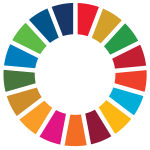Esta web utiliza cookies para que podamos ofrecerte la mejor experiencia de usuario posible. La información de las cookies se almacena en tu navegador y realiza funciones tales como reconocerte cuando vuelves a nuestra web o ayudar a nuestro equipo a comprender qué secciones de la web encuentras más interesantes y útiles.
Graduation: Thesis projects on the SDGs - virtual and physical shows
Description
Institution
The Royal Danish Academy - Architecture, Design, Conservation
Organizations/areas of the university involved
Architecture, Design, Conservation
Country
denmark
Since 2016 the Academy has implemented the SDGs in our curriculum. More than 1000 graduation projects have had this focus. All are displayed in the virtual and physical graduation exhibitions.
The core of The Royal Danish Academy – Architecture, Design and Conservation is rooted in research, practice, and artistic development. But five years ago, we added a strategic level, when we in 2016 chose to include the SDGs as a focal point of our curriculum.
As designers and architects, we are part of the problem so we must also be part of the solution. We believe that the SDGs can inspire our students to consider how we should design and build in the future. We use a holistic perspective to provide new, original, and necessary solutions to the challenges addressed by the goals. In addition, aesthetic considerations are essential to sustainability.
The focus is reflected in our study programs and research projects and reaches its climax in the graduate projects, where all graduate students are asked to relate to the SDGs. The graduates focus on one or more goals, but it is also possible for them to opt out of this agenda. At the same time, the projects are built on the programmes’ basis in research, practice, and artistic development.
All projects are displayed in our final graduation show. In 2020, due to the COVID-19 pandemic, we transformed the graduation show into an online format, where visitors could search on a particular SDG – and find specific projects related to the goal. In 2021 we are going to work even further on this successful way of presenting the graduate projects to a wide audience.
The target groups of the exhibitions are future employers, the business community and stakeholders, the public sector and opinion makers, NGOs and academia.
By choosing an online format we wish to inspire communities worldwide to take advantage of the skills of architects, designers, and conservators in solving the major challenges of our planet – today and in the future.
Originally our work with the SDGs was a 3-year focus to make a change towards sustainability within our institution. Now the focus is deeply rooted in our institution and we will continue this focus and contribute to fulfilling the goals by 2030.
Please note: the 2021 online show will be published July 2021.
If you wish to see the 2020 show, please contact Inge Henningsen for a link.
Results and impact measured or expected
By now more than 1000 graduates have created their final graduate projects relating to one or more of the SDGs. The graduate shows generate a lot of publicity. The skills of the graduates have already proven useful to the Danish business community, and the graduates are able to create change and impact in their work life. On this basis, the Academy has established new collaborations with both industry and academia – and with the political arena.
The virtual exhibition has reached an international audience and has been viewed by stakeholders all over the world. The SDGs are now a signature of our graduation shows.
Connection with the SDG framework
By implementing the SDGs in the curriculum of our study programs, the students are learning to analyze, understand, and work with the challenges addressed by the SDGs right from the beginning of their study. Consequently, when working on their graduate project they have already acquired methods and tools which enable them to ask, how they, by using their specific skills, can create solutions to the SDGs. Combining problem-oriented scenarios and a vast amount of creative energy, the students have demonstrated that they can create original new solutions which can contribute to a more sustainable future for all of us.
We believe that future generations of architects, designers, and conservators – like the ones we are educating at The Royal Danish Academy – must be capable of exploiting this potential.
Barriers and follow up
In the beginning, we had many discussions about whether it was desirable to focus on the SDGs in our research and teaching. Would that affect the freedom of research? Would it affect the students’ free choice of themes that they wanted to work with? We decided that the students, when doing their graduation project, could also justify why they may not want to work with the goals. In this way, we created academic freedom. Today, the majority of our students see the SDGs as a useful framework for working with the major pressing challenges of our time. It helps them to create solutions to problems that may seem unmanageable.
Transferability of the initiative
We believe that the initiative could very well be introduced in all educational institutions. When students implement the issues described in the SDGs, they relate their focus and research to real life problems. Their proposed solutions become highly applicable and relevant to the actual needs of society and people. This is relevant to all educational institutions and geographical contexts.
Education 4 SDG funciona gracias a WordPress



